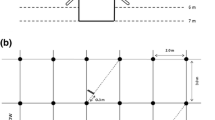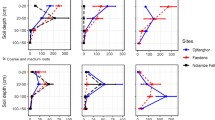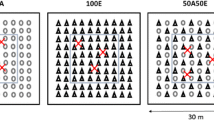Abstract
Planting trees, in farm forestry enterprises, to control rising watertables is an increasing practice for both economic and environmental benefits. One central biophysical issue which determines the effectiveness of trees to control groundwater is the ability of trees to grow roots through degraded soils and take up groundwater. We investigated the effect of soil properties, especially the presence of shallow watertables and site preparation practice, on the vertical and horizontal distributions of Eucalyptus grandis W. Hill ex Maiden and Corymbia maculata (Hook.) K.D. Hill and L.A.S. Johnson roots. In order to improve the reliability of root data, we measured root growth and distribution by three different methods – (i) number of roots intercepting the vertical plane of the soil profile, (ii) root length density in soil cores taken at different depths but in the horizontal plane of the profile, and (iii) root length density in soil cores in the vertical plane at different radial positions from trees and compared the results. Two experimental sites were established in flood-irrigated, farm forestry plantations on contrasting soils in the Murray Riverina region of south-eastern Australia. At one site (Norwood Park), we studied a 58-month-old stand of E. grandis growing in clay loam overlaying medium clay, saline, sodic and alkaline subsoil with a saline (11.5 dS m−1) watertable at 2.8 m depth. Here, there were few roots growing above the watertable. The Karawatha site had adjacent stands of 46-month old E. grandis and C. maculata growing in a sandy, neutral and non-saline soil with a shallow (3.1 m deep) non-saline (2.8 dS m−1) watertable. Here roots proliferated above the watertable in both species but to a much greater extent under C. maculata than under E. grandis. Root distributions in the surface soil were similar at all sites but differences in root growth in the capillary zones paralleled differences in groundwater uptake by trees. We conclude (i) that appropriate matching of species with site characteristics, especially soil and groundwater properties, will enhance tree growth and groundwater uptake and (ii) that extensive planting of C. maculata over non-saline watertables maximises the chances of achieving the multiple objectives of regional groundwater control, fast growth rates and reduced irrigation demand.
Similar content being viewed by others
References
P.J. Baldwin H.L.T. Stewart (1987) ArticleTitleDistribution, length and weight of roots in young plantations of Eucalyptus grandis W. Hill ex Maiden irrigated with recycled water Plant Soil 97 246–252 Occurrence Handle10.1007/BF02374947
J. Bauhus C. Messier (1999) ArticleTitleEvaluation of fine root length and diameter measurements obtained using RHIZO image analysis Agron. J. 91 142–147 Occurrence Handle10.2134/agronj1999.00021962009100010022x
D.T. Bell (1999) ArticleTitleAustralian trees for the rehabilitation of waterlogged and salinity-damaged landscapes Aust. J. Bot. 47 697–716 Occurrence Handle10.1071/BT96110
R.G. Benyon N.E. Marcar S. Theiveyanathan W.M. Tunningley A.T. Nicholson (2001) ArticleTitleSpecies differences in transpiration on a saline discharge site Agric. Water Manage. 50 65–81 Occurrence Handle10.1016/S0378-3774(00)00121-9
W. Böhm (1979) Methods of Studying Root Systems Springer-Verlag Berlin, Germany 188
M.H. El-Lakany S.Y. Mohamed (1993) ArticleTitleRoot characteristics of four tree species as affected by irrigation systems Alex. J. Agric. Res. 38 211–227
A. Fabiao E. Steen M. Madeira (1987) ArticleTitleRoot mass in plantations of Eucalyptus globulus in Portugal in relation to soil characteristics Arid Soil Res. Rehabil. 1 185–194
R.J. George R.A. Nulsen R. Ferdowsian G.P. Raper (1999) ArticleTitleInteractions between trees and groundwaters in recharge and discharge areas – A survey of Western Australian sites Agric. Water Manage. 39 91–113 Occurrence Handle10.1016/S0378-3774(98)00073-0
R.F. Isbell (1996) The Australian Soil Classification CSIRO Publishing Collingwood, Australia 143
F.M. Melhuish R.G. Lang (1967) ArticleTitleQuantitative studies of roots in soil. 1. Length and diameters of cotton roots in a clay-loam soil by analysis of surface-ground blocks of resin-impregnated soil Soil Sci. 106 16–22 Occurrence Handle10.1097/00010694-196807000-00003
J.D. Morris J.J. Collopy (1999) ArticleTitleWater use and salt accumulation by Eucalyptus camaldulensis and Casuarina cunninghamiana on a site with shallow saline groundwater Agric. Water Manage. 39 205–227 Occurrence Handle10.1016/S0378-3774(98)00079-1
InstitutionalAuthorNameMurray–Darling Basin Ministerial Council (2001) Basin Salinity Management Strategy 2001 – 2015 Murray–Darling Basin Ministerial Council Canberra
InstitutionalAuthorNameMurray Irrigation Limited (2003) Murray Irrigation Limited Annual Report 2003 Murray Irrigation Ltd. Finley, NSW, Australia
B.J. Myers R.G. Benyon S. Theiveyanathan R.S. Criddle C.J. Smith R.A. Falkiner (1998) ArticleTitleResponse of effluent-irrigated Eucalyptus grandis and Pinus radiata to salinity and vapour pressure deficits Tree Physiol. 18 565–573 Occurrence Handle12651343
E.K.S. Nambiar (1983) ArticleTitleRoot development and configuration in intensively managed radiata pine plantations Plant Soil 71 37–47 Occurrence Handle10.1007/BF02182639
E.K.S. Nambiar (1990) ArticleTitleInterplay between nutrients, waterroot growth and productivity in young plantations For. Ecol. Manage. 30 213–232 Occurrence Handle10.1016/0378-1127(90)90138-2
S. Nambiar R. Cromer A. Brown (2000) Towards restoring tree cover in the Murray–Darling Basin S. Nambiar R. Cromer A. Brown (Eds) Restoring tree cover in the Murray-Darling Basin CSIRO Forestry and Forest Products Canberra, Australia 59–60
E.K.S. Nambiar R. Sands (1992) ArticleTitleEffects of compaction and simulated root channels in the subsoil on root developmentwater uptake and growth of radiata pine Tree Physiol. 10 297–306 Occurrence Handle14969986
InstitutionalAuthorNameNSW Department of Land and Water Conservation (1998) Groundwater resource status – lower Murray alluvium, Report No 4. Department of Land and Water Conservation NSW, Sydney, Australia
InstitutionalAuthorNameNSW Department of Land and Water Conservation (2000) Taking on The Challenge: The NSW Salinity Strategy Department of Land and Water Conservation NSW, Australia, Sydney
P.J. Polglase S. Theiveyanathan R.G. Benyon R.A. Falkiner (2002) Irrigation management and groundwater uptake in young tree plantations growing over high watertables Rural Industries Research and Development Corporation Canberra, Australia
N.J. Schofield (1992) ArticleTitleTree planting for dryland salinity control in Australia Agrofor. Syst. 20 1–23 Occurrence Handle10.1007/BF00055303
R. Stirzaker R. Vertessy A. Sarre (Eds) (2002) Trees, water and salt: an Australian guide to using trees for healthy catchments and productive farms Joint Venture Agroforestry Program Canberra, Australia 159
D. Sun G.R. Dickinson (1997) ArticleTitleA screening trial of 28 species conducted on non-saline and saline soils in dry tropical northeast Australia J. Sustain. For. 5 1–13 Occurrence Handle10.1002/(SICI)1099-1719(199703)5:1<1::AID-SD58>3.0.CO;2-2
Vertessy R., Connell L., Morris J., Silberstein R., Heuperman A., Feikema A., Mann L., Komarznski M., Collopy J. and Stackpole D. 2000. Sustainable hardwood production in shallow watertable areas. Rural Industries Research Development Corporation. Publication No. 00/163. 105 pp.
Author information
Authors and Affiliations
Corresponding author
Rights and permissions
About this article
Cite this article
Falkiner, R.A., Nambiar, E.K.S., Polglase, P.J. et al. Root distribution of Eucalyptus grandis and Corymbia maculata in degraded saline soils of south-eastern Australia. Agroforest Syst 67, 279–291 (2006). https://doi.org/10.1007/s10457-005-5258-z
Received:
Accepted:
Issue Date:
DOI: https://doi.org/10.1007/s10457-005-5258-z




